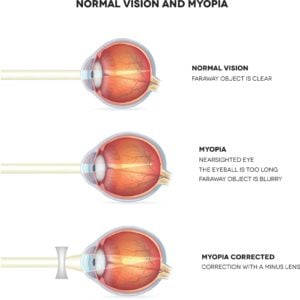Blurry vision might mean you’re suffering from a refractive error. It’s a common eye condition that affects millions worldwide.
In this article, we’ll delve into the four main types of refractive errors, how they’re diagnosed, and the various treatment options available to help you see clearly again.
What Are the 4 Types of Refractive Errors?
Refractive errors are the most common type of eye disorder. They occur when light doesn’t bend correctly into the retina, resulting in blurry vision and other visual impairments.
The four types of refractive errors include:
- Nearsighted (myopia). Blurry vision when seeing things from farther away. Occurs when the eyeball grows too long from front to back
- Farsighted (hyperopia). Blurry vision when seeing things from up close. Occurs when the eyeball is shorter than it should be.
- Astigmatism. Causes up-close and far-away objects to appear blurry. Occurs when your eye isn’t completely round.
- Presbyopia. An age-related refractive error that nearly everyone experiences after 40. Causes difficulty focusing on close objects, especially while reading.
About 153 million people worldwide have visual impairments due to an untreated refractive error. Because of this, it’s important to get routine eye exams to detect refractive errors early.
How Are Refractive Errors Diagnosed?
Your optometrist or ophthalmologist can diagnose refractive errors by performing various tests. Additionally, they’ll check overall health and ask if you have a family history of refractive errors.
The tests your doctor may conduct include:
- Visual acuity test. This measures your distance vision.
- Refraction test. This determines your prescription for corrective lenses.
- Slit-lamp exam. This allows your doctor to examine your eyes’ structures.
If you think your child has a refractive error, a pediatrician might be able to detect it through a routine vision screening. However, your eye doctor may use retinoscopy to diagnose refractive errors if your child can’t read the letters on a typical eye exam.
Treatment Options For Refractive Errors
Your treatment will depend on various factors, such as the type of refractive error, the severity of the condition, your lifestyle, and your age.
However, you can talk to your doctor about your vision goals. They’ll recommend different treatment options to suit your needs.
These treatment options include:
| Treatment | Description | Types |
| Glasses | Prescription eyeglasses are the most common treatment option for refractive errors. There are also different lens types that are designed to address errors at different ranges. | Single vision lensesBifocal lensesTrifocal lensesProgressive/multifocal lenses |
| Contacts | Similar to glasses, contact lenses come in different forms to address refractive errors with monovision, bifocal, and multifocal lenses. | Rigid gas-permeable (RGP)Daily-wear soft lensesExtended-wearExtended-wear disposablePlanned replacement |
| Surgery | Refractive surgery reshapes the shape of your cornea to offer a permanent or long-term solution to refractive errors. Different types of surgeries are available for specific eye problems, and all are relatively safe. | LASIK (laser in-situ keratomileusis)PRK (photorefractive keratectomy)LRI (limbal relaxing incision)ALK (automated lamellar keratoplasty)LTK (laser thermal keratoplasty)CK (conductive keratoplasty)Intacs (intracorneal ring) |
Talk to your eye doctor or surgeon about the best treatment option for your condition. You should also consider each treatment option’s benefits, risks, and costs.
What Factors Affect Refractive Errors?
Anyone can develop refractive errors at any age, and there’s no way to prevent them. Refractive errors are usually hereditary, so some people are born with them.
Most refractive errors, including myopia, typically begin in childhood. Some types, such as presbyopia, are more common in adults over 45.
Additionally, environmental factors like frequent reading, prolonged computer use, and spending less time outdoors can increase your risk of refractive errors. Refractive errors are also more common in big cities and places with intense schooling.
What Can You Do About It?
Although there’s not much you can do about your genetics, there are proactive steps you can take to slow its progression. For example, you can get regular eye exams to monitor your vision and catch vision problems early. This is especially helpful for kids.
To reduce eye strain, you can take frequent breaks from reading or computer screens for at least 20 minutes. Going outside can also be beneficial because natural sunlight can help slow the progression of myopia.
Finally, be sure to wear protective eyewear when going outside. These can protect your eyes from harmful UV rays.
Side Effects of Refractive Errors
If left untreated refractive errors can affect your eye health and quality of life. Here are some of the common side effects of refractive errors:
- Eye strain and headaches
- Discomfort and fatigue when reading, using digital devices, etc.
- Increased risk of accidents due to poor vision
- Self-esteem issues
- Increased risk of lazy eye (amblyopia)
- Increased risk of eye complications (retinal detachment, glaucoma, and myopic macular degeneration)
Additionally, refractive errors can lead to difficulties with academic performance, productivity, and other daily activities. It can also affect your participation in sports and other active hobbies.
Although refractive errors are common and hereditary, there are various ways to manage them. Modern technology and surgeries have made fixing them safe and effective. Talk to your eye doctor about these treatment options to see which are best for you.
In this article







